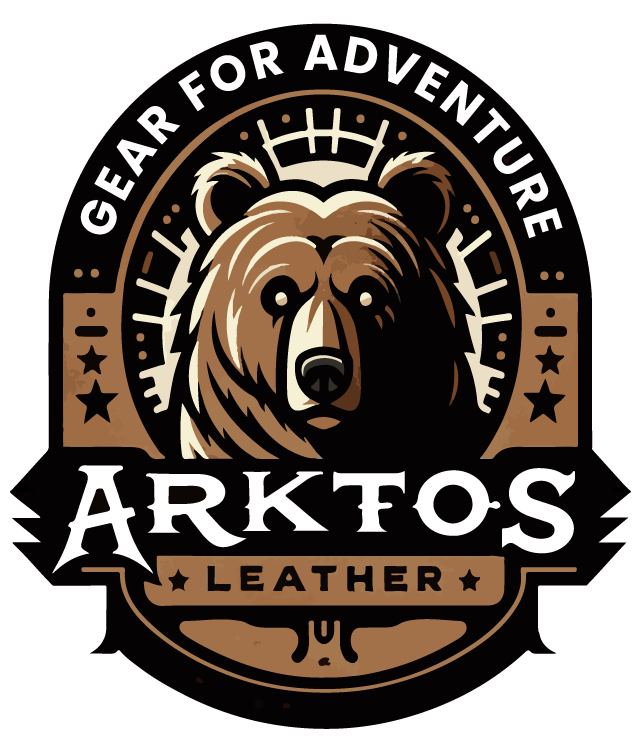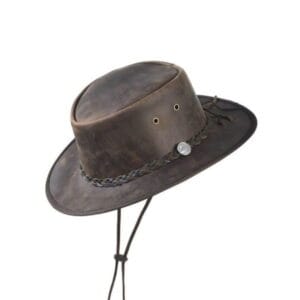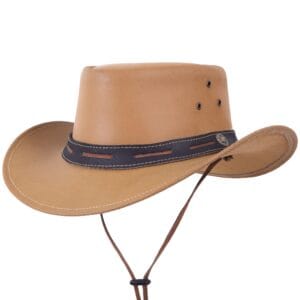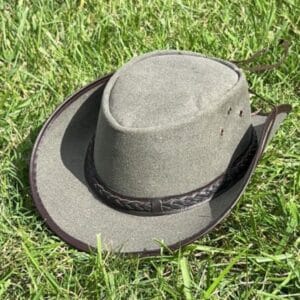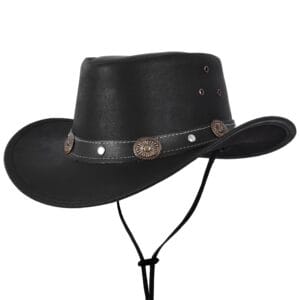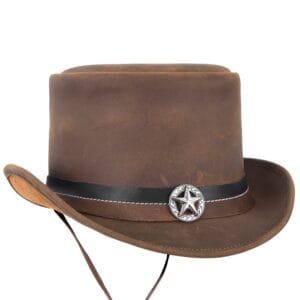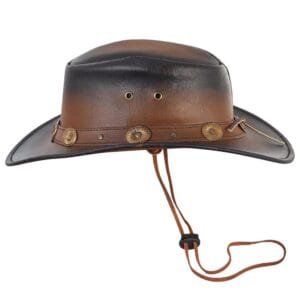When it comes to accessories, leather hats, and cowboy hats in particular, are extremely popular due to their longevity, fashionable appearance, and practicality. On the other hand, these hats have the potential to develop unpleasant scents over time, particularly as a result of the accumulation of sweat. The purpose of this book is to provide comprehensive information on a variety of cowboy hats, as well as practical methods for removing perspiration odors from leather hats.
Distressed Brown Vintage Leather Hat W/Adjustable Chinstrap
Types of Cowboy Hats
Cowboy hats are available in a wide range of materials and styles, each of which has its own set of distinguishing qualities. To ensure proper care and maintenance, it is essential to have a solid understanding of these distinctions.
1. Leather Cowboy Hats
Leather cowboy hats are well-known for their longevity as well as their timeless sophistication. Hat-making can be done with a variety of leathers, including the following:
a) Full Grain Leather:
- Finest grade leather available
- Produced by using the uppermost layer of the hide
- Maintains the inherent grain and flaws of the material
- Patina that is distinctively developed over time
- Exceptionally long-lasting and resistant to water
Black Genuine Leather Braided Cowboy Rodeo Hat
b) Top Grain Leather:
- Second Highest quality leather
- Full grain hides with defects removed from the upper split of the hide, which has a more uniform appearance than full grain
- Reduced in thickness and more malleable
- Not as long-lasting but still of an excellent quality
c) Suede:
- produced by using the reverse side of the animal’s hide
- Soft and napped surface
- Less long-lasting than leather that is smooth
- In order to preserve its look, it requires specific attention.
Shapeable Genuine Leather Western Cowboy Hat
d) Nubuck
- Nubuck is the leather of the highest quality that has been sanded or buffed
a surface that is velvety and resembles suede
Superior to suede in terms of durability, but inferior to full-grain leather
Maintaining its appearance requires frequent maintenance to be performed.
2. Felt Cowboy Hats
Felt hats are a prominent category in cowboy hat styles, despite the fact that they are not made of leather.
a) Felt made of wool:
- Produced by compressing the fibers of wool
- Long-lasting and resistant to any water
- In a variety of qualities (expressed as Xs)
- The fur of rabbits and beavers are two examples of common materials.
b) Felt made of fur:
- Superior to wool felt in terms of quality
- Animal fur, typically rabbit, beaver, or mink, is used in its production.
- However, it is more expensive but lasts longer.
- Exceptional ability to maintain shape and resistance to water
Olive Western Denim Cowboy Hat With Braided Leather Hat Band
3. Cowboy hats made of straw
Hats made of straw are a popular choice for warm weather:
a) Natural Straw:
- Produced from plant fibers such as sea grass or wheat straw
- Airy and lightweight in construction
- lower in durability compared to leather or felt
- In general, more reasonably priced
b) Synthetic Straw
- Composed of materials that were manufactured by humans
- It is more long-lasting than natural straw.
- Most of the time, more reasonably priced
- Can imitate the appearance of straw that is found in nature
Water Resistant Genuine Black Leather Cowboy Western Hat
4. Specialized cowboy hats
a) Palm leaf hats:
- Created by weaving together palm leaves
- Airy and lightweight in construction
- The cost is typically lower than that of leather or felt.
- Increasingly common in tropical regions
b) Hats made of Buckskin:
- Made from deerskin or another type of leather that is supple and flexible.
- They are well-known for their delicacy and adaptability.
- Typically embellished with motifs from the local culture or beading
5. Diverse Forms and Designs of Cowboy Hats
The crown and brim can take on a variety of shapes, including the following:
a) The Cattleman:
- The most typical fashion
- a crazed crown with a small dip in the front and a brim that is medium in width
b) The Gus:
- An elevated crown with a deep crease in the middle
- Wide brim that is turned up
Two Tone Leather Western Style Cowboy Hat With Buffalo Nickel Band
c) Gambler Hat
- With a wide, flat brim and a round, flat crown
d) Pinched Front:
- The front of the crown is pressed in.
- The “cowboy way” is frequently associated with this.
As for Tom Mix:
- Elevated and wrinkled crown
- Expanded and rolled brim
- Taking its name from the well-known cowboy actor from silent films
Collectors and people who are considering purchasing cowboy hats should make it a priority to educate themselves on the numerous types and styles of cowboy hats. It is important to note that each variety has its own specific care requirements, particularly with regard to treating difficulties such as sweat odors.
Black Leather Western Style Cowboy Hat With Conchos Band
The Factors That Contribute to the Odor of Leather Hats
In order to effectively prevent and treat odor in cowboy leather hats, it is essential to have a solid understanding of the underlying reasons of the stench. There are a number of key causes that contribute to unpleasant odors, including:
- Water, salts, and organic molecules are all types of substances that can be found in human perspiration. Leather has the potential to absorb these components, which can then contribute to the production of an odor.
- The warm and wet surroundings that are formed by sweat are suitable for the growth of bacteria because they provide warm and moist conditions. The components of perspiration are broken down by these microbes, which results in the production of odorous metabolites.
- An accumulation of skin cells and oils can occur in the interior of the hat, particularly in the sweatband area. This is because the natural shedding of skin cells and the discharge of oils from the scalp can cause these substances to accumulate.
- Exposure to wetness, high humidity, or incorrect storage can increase odor problems by encouraging the growth of microorganisms and preventing the product from drying out properly. Environmental factors include these factors.
- Degradation of Leather: The breakdown of leather fibers over time can lead to unpleasant scents, particularly if the hat is not well maintained. This is especially true if the hat is worn frequently.
Making Arrangements for Cleaning
Before commencing the process of cleaning, it is important to collect the following materials:
- Brush with gentle bristles
- Cloths that are spotless and devoid of lint
- A cleaning for leather that is pH-balanced and designed specifically for leather applications
The conditioner for leather
- The white vinegar
- Baking soda
- Bottle for spraying
- Water that has been distilled
- The use of absorbent paper or newspaper
- Spray used to leather to weatherproof it (optional).
Ensure that you are working in an area that has adequate ventilation in order to facilitate drying and the dispersion of odors from cleaning agents.
Vintage Style Genuine Leather Top Hat with Decorative Star Hatband
Step-by-Step Process of Cleaning
Brushing and preliminary inspection take place:
- Examine the hat to see if there are any spots that are unusually dirty or damaged.
- The surface filth and dust should be removed from the entire hat by using a brush with soft bristles and brushing it gently.
Ventilation and Odor Elimination:
- A number of hours should be spent in a well-ventilated environment for the hat to be allowed to air out.
- To begin the process of deodorizing the hat, sprinkle baking soda inside the hat, paying particular attention to the sweatband. After letting it to sit for a full night, brush it out thoroughly.
The treatment with a vinegar solution:
- In a spray bottle, combine white vinegar and distilled water until they are in equal parts.
- Mist the interior of the hat, paying particular attention to the region closest to the sweatband.
- Permit the solution to sit for fifteen to twenty minutes now.
- A clean, dry cloth should be used to blot any surplus wetness.
The Cleaning of Leather:
- It is recommended to use a moist cloth to apply a tiny amount of leather cleaning.
- Utilizing circular strokes, clean the exterior as well as the interior of the hat in a gentle manner.
- Particular attention should be paid to the sweatband as well as any areas that are visibly soiled.
- Using a clean cloth that has been dampened, remove any surplus cleaner.
Dual Tone Genuine Cow Leather Unisex Cowboy Hat
Drying:
- It is recommended to stuff the hat with absorbent paper or newspaper in order to keep its shape and to absorb moisture.
- Please let the hat to dry naturally in the air. Stay away from sources of heat and direct sunshine, since they might cause harm to the leather.
The neutralization of odors (if it is required):
- In order to eliminate lingering odors, you can make a paste by combining baking soda and a trace quantity of water.
- The sweatband should be the primary focus of this paste’s application to the interior of the hat.
- Let it sit for a full night, and then remove the dried paste with a brush.
Putting in place:
- Following the completion of the drying process, add a very small layer of leather conditioner to the hat.
- Using a clean cloth and circular motions, work the conditioner into the leather until it is completely absorbed.
- Maintaining the leather’s elasticity and minimizing cracking are both benefits of this phase, which helps return moisture to the leather.
Concluding Buffing:
- After the conditioner has been absorbed, the shine of the hat can be restored by gently buffing it with a dry, soft cloth.
Men’s Brown Leather Top Hat With Studded Hat Band
Maintenance and Preventative Measures on the Whole
If you want to keep the quality of your leather hat and reduce the likelihood of odors coming back, you should:
- Airing on a Regular Basis: After each use, make sure to let the hat air out in a location that has adequate ventilation.
- The rotation method involves switching between different hats in order to ensure that there is sufficient time for drying in between each use.
- The correct way to store hats is to keep them in a cool, dry environment that has adequate air circulation. When you want to keep your hats in shape and avoid crushing them, use a hat rack or a hat box.
- When it comes to absorbing perspiration, you might want to think about utilizing sweatbands or hat liners that are simple to remove and clean.
- Immediately Cleaning: If there is a spill or stain, you should clean it as soon as possible to prevent it from being embedded in the leather.
- Brush your hat on a regular basis and condition the leather at least once every few months, or more frequently if necessary, depending on how often you wear it and the external weather conditions.
- For hats that are frequently exposed to damp, it is recommended that a leather waterproofing spray be used in accordance with the instructions provided by the manufacturer.
- Professional Cleaning: If you own an antique or rare hat, you should think about hiring a professional cleaning service once a year or whenever it is necessary.
Particular Considerations Applicable to the Various Types of Leather
Leather that is both full grain and top grain:
- In general, these sorts are more water resistant and easier to clean than other types.
Conditioning on a consistent basis is essential in order to preserve their quality.
The Suede and the Nubuck:
- Staining and wetness are more likely to cause damage.
- Cleaners that are formulated specifically for suede and nubuck should be used.
- Both a suede brush and an eraser have the potential to be useful for spot cleaning.
Unique Leathers (such as ostrich and crocodile, for example):
- Could necessitate the use of specific care items.
- Consider seeking the assistance of a trained professional for cleaning and upkeep.
It is possible for owners of leather hats to properly eliminate perspiration odors in their hats by according to these rules, which will also preserve the integrity and beauty of the leather. The key to extending the life of these classic items is to perform routine maintenance and to store them in the appropriate manner.
